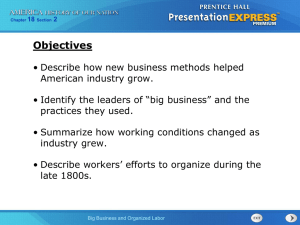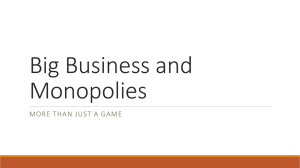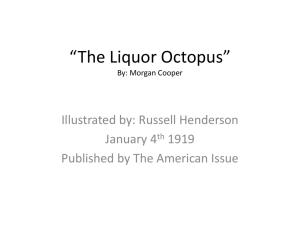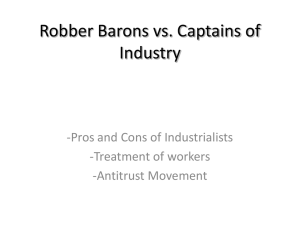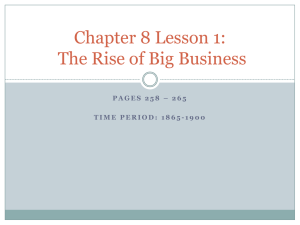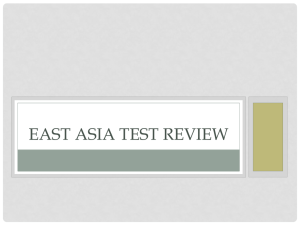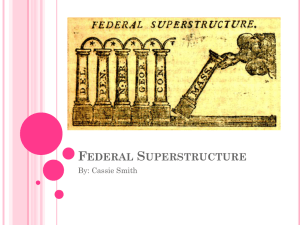2nd Industrial Revolution
advertisement
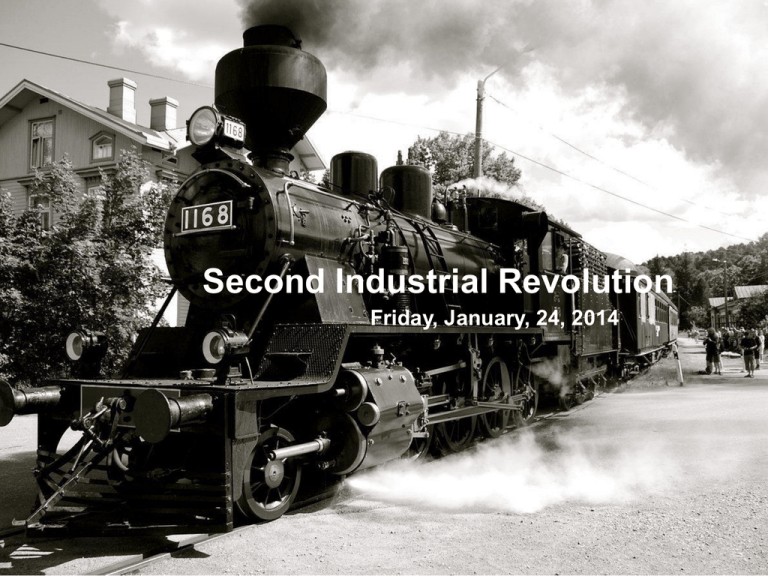
Second Industrial Revolution Friday, January, 24, 2014 Do Now Post a tweet advertising a new invention that will make life easier. What is your invention? How does it work? How will it benefit mankind? Background First Industrial Revolution 1. Changed Way Products Made: Handwork to Machinery 2. Changed Workplace: Cottages to Factories 3. Advances in transportation (steamboats, locomotives) & communication (telegraph) Second Industrial Revolution 1. New Technology (Steel Manufacturing) 2. New Sources of Power (Oil & Electricity) Second Industrial Revolution A period of rapid growth in U.S. manufacturing in the late 1800s. By the mid 1890s, the United States had become the world’s industrial leader. I’ll call it the Bessemer Process! I’ll manufacture steel quickly and cheaply Henry Bessemer Bessemer Process A way to manufacture steel quickly and cheaply by blasting hot air through melted iron to quickly remove impurities. Cheaper steel lowered the cost of building railroads. Companies built miles and miles of new railroads. More jobs were available Increased western growth by offering free tickets to settlers. Improved passenger service with elegant passenger and sleeping cars. Manufacturers and farmers sent products to market faster than ever before. (New refrigerator cars) Cities where major lines crossed grew rapidly Oil In the 1850s, chemists invented a way to convert crude oil into fuel called kerosene. Kerosene could be used for cooking, heating, and lighting. Use of Oil & Electricity as a Power Source Suddenly, there was a demand for oil and people began searching for a reliable oil source. Wildcatters, or prospectors drilled for oil in Ohio, Pa, and WV. Oil companies built refineries to change the crude oil into finished products like kerosene. Electricity Major source of light and power. Edison & his team invented electric lightbulb Problem: few homes & buisnesses could get electricity Solution: Edison built a power plant that supplied electricity to dozens of NYC buildings in 1882. George Westinghouse built a power system that could send electricity across many miles. Lit homes, businesses, factories, & powered street cars in cities across the nation Thomas Edison George Westinghouse Inventions - Communication Telegraph Telephone By 1861, telegraph wires connected the East and West coasts Alexander Graham Bell patented the telephone in March 1876. 5 years later, telegraph cable ran on the floor of the Atlantic Ocean which connected the U.S. to Great Britain Telephone companies raced to lay thousands of miles of phone lines. Problem: telegraphs were only written messages and was difficult to use. By 1900, there were almost 1.5 million telephones in the U.S. I was a Scottish-born speech teacher, who studied the science of sound I called the telephone the “talking telegraph” Inventions - Transportation Henry Ford introduced the Model T car in 1908. Early cars were expensive to build, so only wealthy people owned them However, Ford was the 1st to use the assembly line to manufacture cars. This reduced the cost of producing cars, thus making them more affordable. Inventions - Transportation Wilbur & Orville Wright built a lightweight airplane that used a small gas-powered engine. In Kitty Hawk, NC, Orville made the first piloted flight in a gas-powered plane on December 17, 1903. Two Results: Changed the way people traveled in the future. Increase the demand for oil production. Activity Inventors Meet & Greet (15 – 20 minutes to research) (5 minutes to greet) HW If they had Instagram during the Second Industrial Revolution… Big Business Section 2 DO NOW: TWITTER WALL If you were there…It is 1895, and your town is home to a large corporation. The company’s founder and owner, a wealthy man, lives in a mansion on a hill. He is a fair employer but not especially generous. Many townspeople work in his factory. You and other town leaders feel that he should contribute more to local charities and community organizations. Post your tweet: How could this business leader help the town more? Forming Corporations Entrepreneurs of the late 1800s established their businesses as corporations, or businesses that sell portions of ownership called stock shares. Leaders of these corporations were the most powerful and respected people of American society at the time. Generating Wealth Successful corporations reward not only the people who own them, but the investors who hold stock, as well. These stockholders invest their money in a corporation and based on the amount of stock they own, they would get a percentage of the corporations profits, called dividends. Although, stockholders own a percentage of the corporation they do not run the business. The owner appoints a board of directors to elect the corporation’s main leaders, such as, the president. Advantages of Corporations 1. 2. Stockholders in a corporation are If a company fails, not responsible for stockholders only business debts. lose the money that they invested. 3. Stockholders are free to sell their stock to whomever they want, whenever they want. Big Business Leaders Andrew Carnegie: Scottish-born, came to U.S. as a poor immigrant •One of most admired businesspeople of the time •Focused on steelmaking •Used vertical integration, owning businesses involved in each step of manufacturing, to lower costs John D. Rockefeller: •Standard Oil Company was country’s largest refinery •Developed horizontal integration, owning all businesses in a field •Formed a trust, grouping many companies under a single board Leland Stanford: •Made fortune selling equipment to miners •Governor of California, one of founders of Central Pacific Railroad, and founder of Stanford University New Practices How rich were they? Robber Barons or Captains of Industry? Participated in ruthless business practices Responsible for making America the leading industrial center in the world. Philanthropists: noun 1. a person who seeks to promote the welfare of others, esp. by the generous donation of money to good causes. People and the government began to question the methods of big business. People and the government began to view big business as a problem in the late 1800s. Concerned about child labor, low wages, and poor working conditions Many business leaders believed in Social Darwinism. Darwin’s “survival of fittest” applied to which human beings would succeed in business and in life in general. The rich get richer, while the poor get poorer Fight for wealth and power – the rich survive and thrive, while the poor are neglected and deprived. Other business leaders believed that the rich should help the poor. Carnegie gave $350 million to charity. Virtually, all he owned. Index Card Monopoly How much are you selling your index cards for? Write down a price between 50 cents and 1 dollar. The Antitrust Movement Critics said many businesses earned their fortunes through unfair business practices. Used size and strength to drive smaller competitors out of business Powerful trusts sold goods and services below market value until smaller competitors went out of business, then raised prices. Some people were concerned when a trust gained a monopoly, or total ownership of a product or service. The Sherman Antitrust Act passed in 1890 made it illegal to create monopolies or trusts that restrained trade. The act did not clearly define a trust in legal terms, so it was hard to enforce. Corporations and trusts continued to grow in size and power. Is a monopoly fair or unfair? In a free-market economic system, people work to make money and companies exist to make profit: individual companies want to make as much profit as possible. Certainly companies would love to be monopolies if this meant that they could make greater profits, as it most certainly would. Without government regulation, companies that become monopolies may lower the quality of their products or services (perhaps by spending less money producing them), or they may raise the price of the goods and services that they sell. U.S. government does not think that monopolies are good for our nation since monopolies can raise prices and lower the quality of goods and services. What are these political cartoons depicting? Work with elbow partner to analyze and find meaning. “King of the World” In 1901 Puck published this political cartoon depicting John D. Rockefeller as a king presiding over a landscape that he has devastated. On his crown are the tools of his empire: four railroads–including Pennsylvania's Reading and Lehigh Valley R.R.s– encircle his crown, which is topped by oil derricks and holding tanks. “Standard Oil Octopus” The Standard Oil Octopus is an example of the control that monopolies had over the economy and the government. This cartoon was published in 1904 during Teddy Roosevelt's presidency. The octopus is controlling the Congress (upper left building), the state capital buildings (upper right building), the shipping (upper left), the railroads (under center tentacle) and other business owner or politicians (lower right corner). The only thing not under control of the octopus is the White House. President Roosevelt is using the Sherman Anti-trust Act to regulate the monopolies. This means that there is no longer "Laissez Faire Economics." Laissez-Faire Economics 1. An economic doctrine that opposes governmental regulation of or interference in commerce beyond the minimum necessary for a free-enterprise system to operate according to its own economic laws. 2. Noninterference in the affairs of others. Apply Your Knowledge: Political Cartoon Analysis What is this political cartoon depicting? Work with your elbow partner to discuss the meaning. Read & Complete Activity w/ elbow partner Graphing & Notebook Response Questions Facebook Profile Cornelius Vanderbilt Andrew Carnegie John D. Rockefeller Leland Stanford J.P. Morgan Do Now TOC: New Practices Page 8 You are the owner of a large corporation. Your goal is to streamline your business practice using either horizontal or vertical integration. Create a diagram illustrating either one of these new practices. Be sure to include a picture of your business and/or finished product and the steps you must take to developing your monopoly. Draw at least 5 steps of either vertical or horizontal integration. Acme Skateboards Shaping Manufacturer Lumber Yard Do Now: Answer Questions About Cartoon Interpreting Political Cartoons 1. What is your interpretation of this political cartoon? 2. Who do the pirates represent? 3. What do “Uncle Sam” and the American flag represent? 4. What is happening to “Uncle Sam” and the American flag? 5. Why is labor the skull in the “Jolly Rogers” flag? 6. What could happening during this period, 1880-1910 that would inspire such a political cartoon? Do Now: YouTube Video (Labor Day) Assembly Line Simulation Job: creating high-quality paper dolls Step 1: Draw the best, most detailed picture of a boy/girl doll that you can. Step 2: Divide class into 4 groups (pick the best doll) Step 3: Assign drawing parts for each person in the group. Step 4: Produce as many high-quality pictures you can in 10 minutes. Debriefing – Evaluate your experience Notebook • How did you feel working as a craftsperson at the beginning of this activity? • How did you feel working on the assembly line? • What factors made producing the drawing on the assembly line difficult or frustrating? • How did members of your group cope with the stress or monotony? • What made you want to work hard? What made you not want to work hard? • How did you feel about the the factory manager? • How did your attitude or feelings change as the activity progressed? • Did you prefer working as an individual craftsperson or working on the assembly line? Explain T-Chart Compare & Contrast (Left Side) The Reality of the Assembly Line Directions: After reading the passage, complete the following T-chart that compares your assembly line experience to what assembly lines were like during the Industrial Revolution. One side will tell you what you actually did in the simulation the other will tell how it was during the Industrial Revolution. You need to cover conditions, rules, environment, and experience. Come up with at least eight corresponding ideas. Advantages & Disadvantages Matrix (Left Side) Assignment (Right Side) Draw a 2 panel cartoon comparing their classroom experience with the realistic experience of assembly work. Use thought bubbles to describe what the workers were feeling at the time. Classroom Experience Historical Reality Do Now: Notecard Describe a time when you were unhappy with certain conditions—at home, work, or school. How did you try to change those conditions? Were you successful? Why or why not? Afterward, share your response with a classmate or the class. Preview In this lesson, you will learn about the working class at the turn of the 20th century. You will explore the working and living conditions that prompted workers to unite and fight for better conditions and pay. the formation of early labor unions. some of the successes and failures of those unions. Notebook – Pages 11 & 12 TOC: Labor Unions Assignments Section 2 Record at least four details describing the working and living conditions of industrial workers. Section 3 Record at least two strategies labor unions employed in their attempt to improve workers’ lives. Then record at least two ways employers attempted to undermine unions. Section 4 Record at least three key events during the labor movement of this time period. Summarize each event in one or two sentences. Section 5 Record at least three important losses or gains that labor unions experienced during this time. Write at least one sentence explaining each gain or loss. Green/Pink Game
